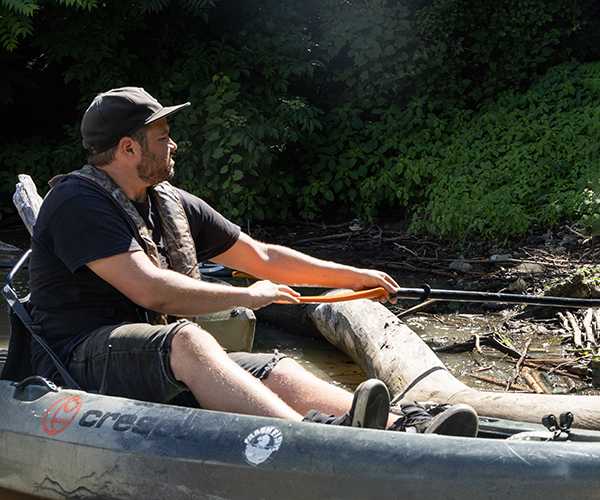At 6 feet, 230 pounds, with a white beard and no apparent tattoos, Tony Tomsic has compiled remarkable numbers when it comes to the National Football League, even though he hasn't played a single down. He's one of only five photographers who have shot all 38 Super Bowls. He has taken more than 60,000 pictures of the event. His career total: an estimated half-million pictures of NFL games.
A photographer with Sports Illustrated and the NFL since 1981, Tomsic will keep his streak alive at Super Bowl XXXIX in Jacksonville this month. At 69, the Rocky River resident says he expects to be the oldest photographer on the field.
Nine of Tomsic's pictures were included in the NFL's 1999 coffee-table book "Best Shots," commemorating the greatest NFL photographs of the century. He counts 20 Sports Illustrated covers to his credit. He also drew Albert Belle's ire in an infamous 1996 baseball-throwing incident.
Tomsic's fondest memories are of the years at the former Cleveland Press, where he photographed everything from murder to zoo life. His image of a civil-rights demonstrator killed by a bulldozer on Cleveland's East Side in 1963 was a finalist for a Pulitzer Prize. It lost to the picture of Jack Ruby's slaying of Lee Harvey Oswald.
Tomsic still possesses the mental edge and physical stamina needed to cover big games. He will take as many as 1,000 exposures, about 30 rolls of film, at Super Bowl XXXIX. The film speed will be 1600 and his adrenalin will be equally quick.
"You can't miss a play," he says. "You never go into a critical play with only three frames left in the camera. You load and reload constantly."
Tomsic will be toting three Canon EOS 1N cameras: one mounted with a 400 mm lens, another with a normal 55 mm lens and a third camera in reserve. A fourth camera — a battered, 25-year-old Olympus that takes great snapshots — will be tucked into his shirt pocket, ready for those unpredictable moments that occur all too frequently.
To anticipate his shots, Tomsic studies the game, the players and their tendencies like a linebacker in an NFL film room. On a bad day, Tomsic says, he can find himself out of position or a shutter-tick off, so he watches every move, looking for details such as which way a kicker turns after a field goal or how deep a wide receiver runs his pass route.
Good sports photographers must know the game and anticipate the play. They almost never see the picture they make in the viewfinder. If they do, it means they missed the shot, for the decisive moment is always blocked by the shutter.
"You think; you miss the picture," Tomsic says with a shrug.
He admits his reflexes have diminished with age; automatic-focus lenses have extended his career. He doesn't think of retirement, but age leaves its calling cards.
Three years ago, high on the steep escalator at Tampa's airport, Tomsic noticed black spots appearing in his right eye. By the time he reached the bottom, the sight in the eye was completely gone.
Bewildered, Tomsic considered going on to shoot the game with his left eye. But after some thought, he returned home and visited The Cleveland Clinic, where doctors repaired a torn retina. While he's regained sight in his right eye, he now uses his left for photography.
Tomsic became a photographer in high school. After seriously injuring his back as a kicker for Cleveland Heights' Monticello Junior High School football team, he turned to the camera as a way of staying with the game.
He was one of those kids whose energy, determination and punctuality at first got in the way — until one day they became indispensable. The Cleveland Press hired Tomsic at age 19 for general assignments, a job that can include covering a murder in the morning, coaxing smiles from the town's social elite by lunch and capturing the scene of a fatal auto accident on the Shoreway at rush hour.
Tomsic joined The Press in 1955, on the cusp of photography's evolution. The bulky, awkward 4x5 press camera was giving way to the smaller, quicker 35 mm version with telephoto lenses and motor drives. Color film could only be used in ideal conditions and, even then, it took patience and skill to get a good shot.
In those early days, Tomsic pursued his interest in sports photography on his own time, covering high-school games and volunteering to assist at Browns games. He occasionally filled in for Fred Bottomer, the newspaper's highly regarded sports shooter and a former World War II Navy photographer whose career reached back into the era of slow film and heavy drinking.
Newspapers were more about words than pictures then. But that didn't stop Tomsic and other Press photographers from innovating, shooting with 35 mm film even though most editors thought pictures were still about sheet film, flash guns and the smell of fixer.
In 1962, Tomsic took a 35 mm picture of a field-goal attempt in a Browns game that was so compelling — catching a Brown in midair over a crowd of players, lunging to block the ball — that it hung in the New York World's Fair.
"We were lucky to have two great sports photographers after Bottomer retired: Tony [Tomsic] and Paul Tepley," says Brent Larkin, editorial director of The Plain Dealer, who worked at The Press at the time. "They were the best. Tony could appear gruff and tough, but beneath all that is a soft and good-hearted guy."
The Press editors, in fact, encouraged Tomsic to free-lance, which eventually led him to leave the newspaper in 1981 to work as a contract photographer for Sports Illustrated.
A photograph of U.S. downhill skier Bill Johnson from the 1984 Olympics in Sarajevo is his best SI cover, Tomsic says. Johnson was outspoken in predicting he'd win a gold medal, and when he did — part of an unprecedented five-medal performance by the U.S. ski team — the magazine's editors chose Tomsic's shot of Johnson coming over a slope, suspended in the air, high above the snow, for the cover.
Tomsic had little experience photographing skiing. So his assistant, a world-class cross-country skier, picked a position on the slope and dug a place in the snow for Tomsic.
To get to his spot, however, Tomsic had to cross the frozen downhill course. With "I Want to be in America" from "West Side Story" blaring over speakers, the crowd started cheering Tomsic, delicately making his way across the icy slope, struggling to maintain his balance on uncharted ice. Finally, he slipped into the spot dug for him and got into position.
"You had to anticipate by the crowd noise and shoot the skier as he came over the slope as the noise grew louder," Tomsic recalls. "It was too late if you actually saw the skier through the viewfinder."
Few Clevelanders can forget the 1986-87 AFC Championship game and "The Drive" — John Elway's 98-yard touchdown march that sent the game to overtime, denying Browns fans a Super Bowl berth.
Tomsic remembers it for other reasons. "It was not a good day for me," he says. "I seemed to be off balance throughout the whole game.
"On the field goal that won the game, I changed my position several times before the ball was snapped," he recalls. "I was lucky to get the kicker at just the right moment."
A Sports Illustrated photo editor called at 1 a.m. to tell him that most of his stuff from the game was pretty bad. Once he'd tossed Tomsic into a funk, he offered that there was at least once decent shot. His picture of kicker Rich Karlis jumping up, arms raised to celebrate his winning field goal, was going on the cover, the editor said.
"I wanted to kill him," Tomsic says.
Super Bowl III is remembered for brash New York Jets quarterback Joe Namath famously predicting victory — and then delivering it — over the heavily favored Baltimore Colts. Though a high point for the emerging NFL, Tomsic says it was one of his worst games.
"I thought the Colts defense would kill Namath," he says. "I was stubborn in the way I approached that game, and positioned myself so that I would get this great picture of Namath getting pounded by that Colt defense."
It never happened. Tomsic's game plan was foiled because he hadn't adjusted to the changing game. The Jets beat the Colts for the first victory by an American Football League team.
Super Bowl I in 1967, between the Green Bay Packers and the Kansas City Chiefs, remains his most vivid Super Bowl memory. Tomsic knew Green Bay well, since the Packers had played the Browns often in the playoffs, and he was ready for their style of play. He remembers best a picture he took of the Packers' Max McGee making a touchdown catch.
In those days, a photographer could follow the action up and down the field, setting up wherever the play seemed headed. Today, there are so many people on the sidelines and television has so much control of the game that still photographers are limited in their movement. Tomsic has often collided with celebrities on the sidelines, so intent in his work that only later did he discover he'd run into Michael Jackson or Bob Hope.
He still resists the future in some ways. He's avoided the conversion from film to the digital technology sweeping photography. (In fact, Sports Illustrated only shoots games digitally now, so Tomsic does most of his work for the NFL.)
"Maybe I'm too lazy, old or just set in my ways," he says about digital cameras. "I'm not into it yet."
Sports photography for Tomsic has not been all success and covers. It's had its harrowing moments, too.
Early in his career at The Press, when baseball photographers were allowed on the field, Tomsic was positioned along the first-base line when Indians first baseman Luke Easter ripped a foul line drive toward him. The ball sped between Tomsic's legs so fast that he did not realize what had happened until the first-base umpire tapped him on the shoulder and said, "Son, you know that ball nearly hit you."
Tomsic retired momentarily from the field to regain his composure.
In a 1969 preseason game, Buffalo Bills tight end Billy Masters collided with Tomsic on the sidelines. Masters' helmet rammed into Tomsic's chin, knocking the photographer unconscious. As Tomsic lay on the ground groggily regaining his senses, the great Cleveland wide receiver Gary Collins leaned down and growled at him: "I'm glad that happened. Now you know how it feels to get hit."
Tomsic's most publicized moment involved former Indians left fielder and bad boy Albert Belle, who often resented having his photograph taken.
Before a game in April 1996, Tomsic snapped pictures of Belle warming up. Shortly thereafter, he heard the whack of a ball hitting a nearby seat. As Tomsic turned, he saw another ball coming at his head. Instinctively, he shielded his face with his hand.
The ball struck his knuckles, drawing both blood and anger. Despite colleagues from all over the country urging him to take action, he planned to ignore the incident. But when Belle appeared on HBO and admitted that he threw at Tomsic, the photographer filed suit and reached a settlement. One Indians player testified for Tomsic in the case. Several others apologized for the incident. Reliever Jose Mesa wondered how anyone could throw a baseball at someone who looked like Santa Claus.
"I don't have any bad feelings toward him," Tomsic says of Belle.
The suit was as much about respect as retribution. Adamant when it comes to photographers' rights, Tomsic argues with television producers who want to restrict his sideline activities, and he's led an effort to protect royalties and credits for those who photograph NFL games.
When Indians rookie Manny Ramirez began to emulate Belle's verbal abuse of photographers, Tomsic thrust his bearded visage into Ramirez's face and told him what would happen the next time he heard that sort of remark.
"You are going to find your ass thrown over the center-field fence," Tomsic said. Manny hugged him and apologized. This summer, when the Red Sox were in town, Ramirez abruptly ended media interviews to greet Tomsic, making the rest of the Sox wonder who the guy with the beard might be.
Photography has been more than a job for Tony Tomsic. He met his wife, Betsy, while covering a story. He enjoys taking photos of his family, which includes daughters Tali and Tami, his 6-year-old granddaughter, for whom he recently bought a camera, and 1-year-old granddaughter.
Over the years, many of Tomsic's photographs have been purchased and published numerous times. One picture that has appeared more times than Tomsic can remember is a portrait of former Pittsburgh Steeler Jack Lambert, who is missing his front teeth.
With his extensive NFL archives, Tomsic is frequently the recipient of unexpected royalty checks. Often, the checks do not mention which photograph was purchased. Tomsic is naturally curious.
"I got this check for $1,500 one day," he says. "That is not chump change. So I called Sports Illustrated and asked what the money was for."
They checked and said: "Send the money back. There has been a mistake."
Tomsic laughs with an irony that can only come from a lifetime of hunting decisive moments.



